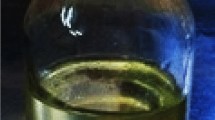Abstract
The biodegradation process of a polycaprolactone (PCL)/eggshell (ES) biocomposite (50/50 w/w) was studied for 8 weeks, using a bioreactor, which allowed to control: temperature, moisture, soil pH, light and anaerobic condition during composting. Scanning electron microscopy showed that the degradation process occurred mainly on the sample surface, attributable to the microbial attack and the weight loss showed a higher degradation for the PCL/ES samples than for pure PCL. Viscometric tests showed that the viscosity of the PCL phase in the biocomposite decreased more than when PCL was used alone, due to the higher depolymerization in the biocomposites. Differential scanning calorimetric thermal scans showed that the crystallization temperature changed for 8 weeks. In conclusion, it was noted that soil pH, heat and an aerobic environment accelerate the degradation process, while a photo-controlled, anaerobic and moisture-saturated environment delays this process, as compared with the composting system used as control.










Similar content being viewed by others
References
Nayak PL (1999) Biodegradable polymers: opportunities and challenges. Macromol Chem Phys 39:481–505
Halada K (2003) Progress of ecomaterials toward a sustainable society. Solid State Mater Sci 7:209–216
Lotto NT, Calil MR, Guedes CGF, Rosa DS (2004) The effect of temperature on the biodegradation test. Mater Sci Eng 24:659–662
Omar F, Andrzej KB, Hans-Peter F (2012) Biocomposites reinforced with natural fibers. Prog Polym Sci 37:1552–1596
Ashori A (2008) Wood–plastic composites as promising green-composites for automotive industries. Bioresour Technol 99:4661–4667
Chen P, McKittrick J, Meyers MA (2012) Biological materials: functional adaptations and bioinspired designs. Prog Mater Sci 57:1492–1704
Hassan MA, Yee LN, Yee PL, Ariffin H, Raha AR, Shirai Y, Sudesh K (2013) Sustainable production of polyhydroxyalkanoates from renewable oil-palm biomass. Biomass Bioenerg 50:1–9
Jayasekara R, Sheridan S, Lourbakos E, Beh H, Christie GBY, Jenkins M, Halley PB, McGlashan S, Lonergan GT (2003) Biodegradation and ecotoxicity evaluation of a bionolle and starch blends and its degradation products in compost. Int Biodeterior Biodegrad 51:77–81
Singh RP, Pandey JK, Rutot D, Degée D (2003) Biodegradation of poli(ε-caprolactone)/starch blends and composites in composting and culture environments. Carbohydr Res 338:1759–1769
Di Franco CR, Cyras VP, Busalmen JP, Ruseckaitea RA, Vázquez A (2004) Degradation of polycaprolactone/starch blends and composites with sisal fibre. Polym Degrad Stabil 86:95–103
Brito Y, Sabino MA, Ronca G, Muller AJ (2008) Changes in crystalline morphology, thermal, and mechanical properties with hydrolytic degradation of immiscible biodegradable PPDX/PCL blends. J Appl Polym Sci 110:3848–3858
Luo W, Chen TB, Zheng GD, Gao D, Zhang YA, Gao W (2008) Effect of moisture adjustments on vertical temperature distribution during forced-aeration static-pile composting of sewage sludge. Resour Conserv Recycl 52:635–642
Mukhopadhyay S, Ramaswamy R (2012) Application of emerging technologies to control Salmonella in foods: a review. Food Res Int 45:666–677
Toro P, Quijada R, Yazdani-Pedram M, Arias JL (2007) Eggshell, a new bio-filler for polypropylene composites. Mater Lett 61:4347–4350
Ishigaki T, Sugano W, Nakanishi A, Tateda M, Ike M, Fujita M (2004) The degradability of biodegradable plastics in aerobic and anaerobic waste landfill model reactors. Chemosphere 54:225–233
Dick WA, Cheng L, Wang P (2000) Soil acid and alkaline phosphatase activity as pH adjustment indicators. Soil Biol Biochem 32:1915–1919
Davis G, Read A, Bulson H, Harrison D, Billett E (2004) Open windrow composting of polymers: an investigation into the rate of degradation of polyethylene. Resour Conserv Recycl 40:343–357
Wu CS (2004) Physical properties and biodegradability of polycaprolactone-maleated/starch composites. Polym Degrad Stabil 80:127–134
Tsuji H, Ikada Y (1998) Properties and morphology of poly (l-lactide). II. Hydrolysis in alkaline solution. J Polym Sci A1 36:59–66
Ganesh M, Gross RA (2012) Embedded enzymatic biomaterial degradation: flow conditions and relative humidity. Polymer 53:3454–3461
Lorenzo AT, Arnal ML, Sanchez J, Muller AJ (2006) Effect of annealing time on the self-nucleation behavior of semicrystalline polymers. J Polym Sci Pol Phys 44:1738–1750
Fukudaa N, Tsuji H, Ohnishia Y (2002) Physical properties and enzymatic hydrolysis of PLLA/CaCO3 composites. Polym Degrad Stabil 78:119–127
Sabino MA (2007) Oxidation of polycaprolactone to induce compatibility with other degradable polyesters. Polym Degrad Stabil 92:986–996
Spevácek J, Brus J, Divers T, Grohens Y (2007) Solid-state NMR study of starch/polycaprolactone blends. Eur Polym J 43:1866–1875
Bayr S, Rintala J (2012) Thermophilic anaerobic digestion of pulp and paper mill primary sludge and co-digestion of primary and secondary sludge. Water Res 46:4713–4720
Mark JE (1999) Polymer Data Handbook. Oxford University Press, Cincinnati
Sabino MA, Albuerne J, Müller AJ, Brisson J, Prud’homme RE (2004) Influence of in vitro hydrolytic degradation on the morphology and crystallization behavior of poly(p-dioxanone). Biomacromolecules 5:358–370
Sabino MA, Ronca G, Müller AJ (2000) Heterogeneous nucleation and self-nucleation of poly (p-dioxanone). J Mater Sci 35:5071–5084
Albuerne J, Marquez L, Muller AJ, Raquez JM, Dege Ph, Dubois Ph, Castelletto V, Hamley IW (2003) Nucleation and crystallization in double crystalline PPDX-b-PCL diblock copolymers. Macromolecules 36:1633–1644
Sabino MA, Feijoo JL, Müller AJ (2001) Crystallization and morphology of neat and degraded poly(p-dioxanone). Polym Degrad Stab 73:541–547
Acknowledgments
The authors would like to thank the Surface Laboratory-Lab E, Electron Microscopy Section, as well as the Polymer Group I-Lab B, both at the Universidad Simón Bolívar, for SEM and DSC analysis, respectively.
Author information
Authors and Affiliations
Corresponding author
Rights and permissions
About this article
Cite this article
González Petit, M., Correa, Z. & Sabino, M.A. Degradation of a Polycaprolactone/Eggshell Biocomposite in a Bioreactor. J Polym Environ 23, 11–20 (2015). https://doi.org/10.1007/s10924-014-0655-x
Published:
Issue Date:
DOI: https://doi.org/10.1007/s10924-014-0655-x




